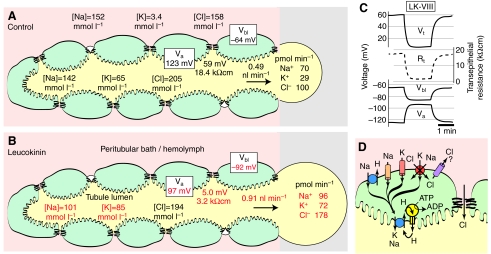Fig. 1.
Leucokinin increases the paracellular Cl– conductance in Malpighian tubules of Aedes aegypti. (A,B) Leucokinin-VIII increases the transepithelial secretion of both NaCl and KCl. Numbers in red indicate a statistical significant difference (P<0.05) from controls; (C) electrophysiological effects of LK-VIII on the transepithelial voltage (Vt) and resistance (Rt) and on the basolateral and apical membrane voltages (Vbl, Va) indicate a transepithelial short-circuit brought about by the sudden increase in paracellular Cl– conductance; (D) model of transepithelial electrolyte secretion in Aedes Malpighian tubules. The transepithelial transport of Na+ and K+ is active and mediated by principal cells; the transepithelial transport of Cl– is passive and mediated by the paracellular pathway and stellate cells. However, under conditions of diuresis triggered by aedeskinin or kinin isoforms, the transcellular and paracellular pathways are electrically so well coupled that the rates of transcellular cation secretion and paracellular anion secretion are equivalent (Beyenbach, 2003; Hayes et al., 1989; Pannabecker et al., 1993; Yu and Beyenbach, 2004).

